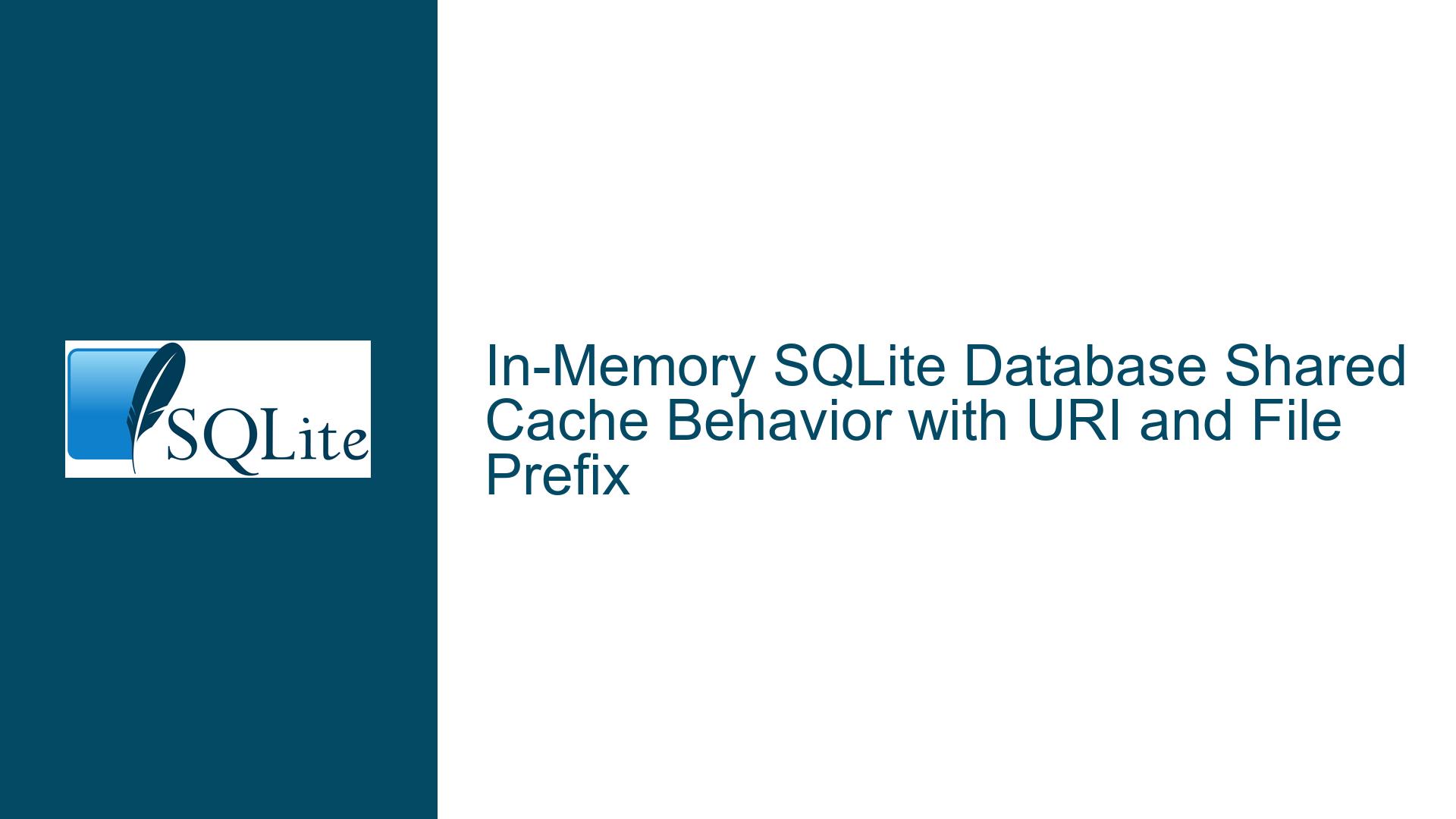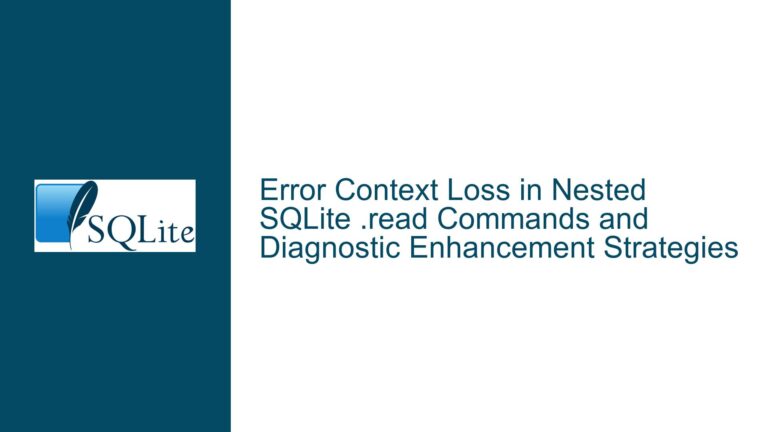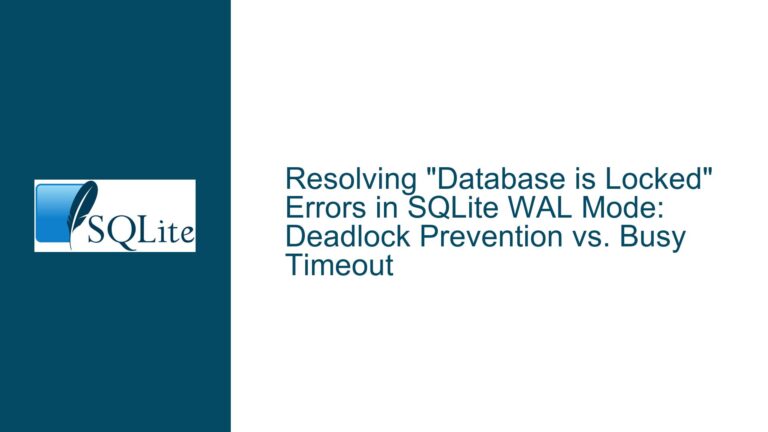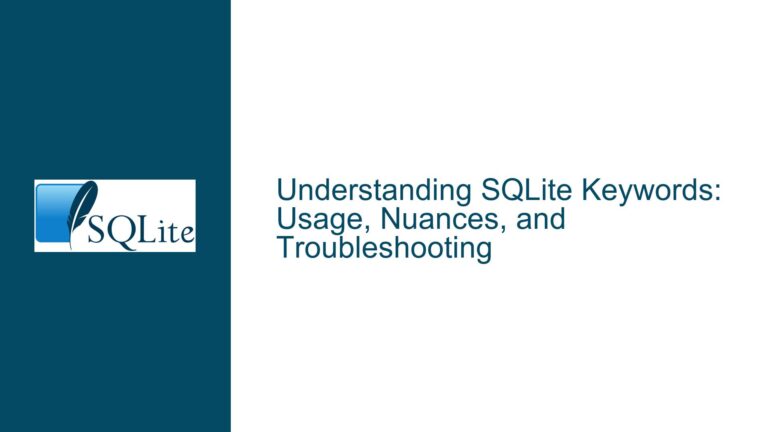In-Memory SQLite Database Shared Cache Behavior with URI and File Prefix
SQLite In-Memory Database Shared Cache Dependency on URI and File Prefix
When working with SQLite in-memory databases, the shared cache feature is a powerful tool for optimizing performance in multi-threaded environments. However, the shared cache functionality exhibits a peculiar dependency on the SQLITE_OPEN_URI flag and the file: prefix when opening the database. Specifically, the shared cache will not function if either the SQLITE_OPEN_URI flag or the file: prefix is omitted during the database connection process. This behavior is rooted in the internal mechanisms of SQLite, particularly in the sqlite3ParseUri and sqlite3BtreeOpen functions.
The sqlite3ParseUri function is responsible for parsing the URI string provided during the database connection. When the SQLITE_OPEN_URI flag is not set, or when the file: prefix is missing, the function removes the flag, which subsequently disables the shared cache. This removal occurs because the shared cache is only enabled if the SQLITE_OPEN_URI flag is present in the sqlite3BtreeOpen function, which is responsible for opening the B-tree structure that underpins the SQLite database.
This dependency can lead to unexpected behavior, especially in scenarios where developers are unaware of the intricate relationship between the SQLITE_OPEN_URI flag, the file: prefix, and the shared cache functionality. Understanding this relationship is crucial for ensuring that the shared cache operates as intended in multi-threaded applications that rely on in-memory databases.
Interplay Between SQLITE_OPEN_URI, File Prefix, and Shared Cache
The shared cache feature in SQLite is designed to allow multiple database connections to share the same cache, thereby reducing memory usage and improving performance in multi-threaded applications. However, the activation of this feature is contingent upon the presence of both the SQLITE_OPEN_URI flag and the file: prefix in the database connection string. The absence of either of these elements will result in the shared cache being disabled, leading to potential performance degradation and increased memory usage.
The sqlite3ParseUri function plays a critical role in this process. When a database connection is established, this function is called to parse the URI string provided in the connection parameters. If the SQLITE_OPEN_URI flag is not set, or if the file: prefix is missing, the function will remove the flag, effectively disabling the shared cache. This behavior is documented in the SQLite source code, specifically in the sqlite3ParseUri function, where the flag is explicitly removed under these conditions.
The sqlite3BtreeOpen function is another key player in this process. This function is responsible for opening the B-tree structure that underlies the SQLite database. The shared cache is only enabled if the SQLITE_OPEN_URI flag is present when this function is called. This means that even if the shared cache is theoretically available, it will not be activated unless the SQLITE_OPEN_URI flag is set during the database connection process.
This interplay between the SQLITE_OPEN_URI flag, the file: prefix, and the shared cache functionality can be confusing for developers who are not familiar with the internal workings of SQLite. It is essential to understand that the shared cache is not a standalone feature but rather one that is tightly coupled with the URI parsing and B-tree opening processes. This coupling ensures that the shared cache is only activated under the correct conditions, but it also means that developers must be diligent in ensuring that these conditions are met when working with in-memory databases.
Ensuring Shared Cache Functionality with Proper URI and Flag Usage
To ensure that the shared cache functionality is activated when working with SQLite in-memory databases, developers must take care to include both the SQLITE_OPEN_URI flag and the file: prefix in the database connection string. This can be achieved by using the sqlite3_open_v2 function with the appropriate flags and URI string, as shown in the following example:
sqlite3_open_v2("file:foobar", &db, SQLITE_OPEN_READWRITE | SQLITE_OPEN_CREATE | SQLITE_OPEN_URI | SQLITE_OPEN_MEMORY | SQLITE_OPEN_SHAREDCACHE, NULL);
In this example, the file:foobar URI string includes the file: prefix, and the SQLITE_OPEN_URI flag is set in the flags parameter. This ensures that the sqlite3ParseUri function will not remove the flag, and the sqlite3BtreeOpen function will enable the shared cache.
It is also important to note that the shared cache functionality is only available when using the SQLITE_OPEN_SHAREDCACHE flag in conjunction with the SQLITE_OPEN_URI flag and the file: prefix. If any of these elements are missing, the shared cache will not be activated, and each database connection will use its own separate cache. This can lead to increased memory usage and reduced performance in multi-threaded applications.
To further illustrate the importance of proper URI and flag usage, consider the following table, which outlines the different combinations of flags and URI strings and their impact on the shared cache functionality:
| URI String | Flags | Shared Cache Enabled |
|---|---|---|
file:foobar | `SQLITE_OPEN_READWRITE | SQLITE_OPEN_CREATE |
file:foobar | `SQLITE_OPEN_READWRITE | SQLITE_OPEN_CREATE |
foobar | `SQLITE_OPEN_READWRITE | SQLITE_OPEN_CREATE |
foobar | `SQLITE_OPEN_READWRITE | SQLITE_OPEN_CREATE |
As shown in the table, the shared cache is only enabled when both the SQLITE_OPEN_URI flag and the file: prefix are present in the database connection string. This highlights the importance of ensuring that these elements are included when working with in-memory databases in a multi-threaded environment.
In addition to ensuring proper URI and flag usage, developers should also be aware of the potential pitfalls associated with shared cache usage. For example, while the shared cache can improve performance by reducing memory usage, it can also lead to contention issues if multiple threads attempt to access the same cache simultaneously. To mitigate this risk, developers should consider using appropriate synchronization mechanisms, such as mutexes or semaphores, to ensure that access to the shared cache is properly coordinated.
Another consideration is the impact of shared cache usage on database transactions. When multiple connections share a cache, transactions that modify the database must be carefully managed to avoid conflicts and ensure data consistency. This may require the use of additional locking mechanisms or transaction isolation levels to prevent issues such as dirty reads or lost updates.
In conclusion, the shared cache functionality in SQLite in-memory databases is a powerful tool for optimizing performance in multi-threaded applications. However, its activation is dependent on the proper use of the SQLITE_OPEN_URI flag and the file: prefix in the database connection string. By understanding the interplay between these elements and the internal mechanisms of SQLite, developers can ensure that the shared cache operates as intended, leading to improved performance and reduced memory usage in their applications.






